Please sign in first
Not a member?

- Home
- Online Education Programs
- ISG Journey Thru Gemology
- ISG Credentials
- Legacy Entrance
- Frequently Asked Questions
- Registry of Graduates
- Careers in Gemology
- Important Program Information
- About the ISG
- Why is the ISG Tuition So Low?
- Testimonials of ISG Students and Graduates
- Meet Your Instructor for your ISG education
- ISG Best Online Gemology School
- Graduate Support Programs
- Ishihara Color Vision Test
- Privacy Policy
- Newsletters
- The Story of Ruby
- Turquoise Investigation by the ISG
- The Story of Petrol Quartz
- Top 5 Myths About Jewelry Insurance Appraisals
- The Story of Time
- The Story of Freshwater Pearls
- The Story of Agates and Jaspers
- Susan Bailey v. Frantz Jewelers, et al.
- The Story of Blue Topaz
- The Story of Tibet Andesine
- The Story of Oregon Sunstone
- The Story of Created Moissanite
- Identifying Lab Created Diamonds
- Black Diamond or Created Moissanite?
- Ebay, the GIA, and Section 230
- Lessons From the Angry Janitor
- Exposing the Truth about Lab-Created Diamonds
- AGTA Hobbles Dealers and Buyers
- Appraisers -v- Gem Labs…a Legal Imbalance!
- Understanding the Classification of Diamonds
- Cremation Diamonds: Insuring and Litigating
- Let’s Talk About Gemology Credentials
- Hometown Jewelers and the Force Majeure Clause
- Following the Critical Angle of Diamond Grading
- When Breitling Brought the Airmen Home
- Let’s Open a Refractometer
- Measuring the Energy of Light
- Quick Reference Guide to Sunstone
- ISG Seeing the Invisible Light
- Contact Us
The Story of Freshwater Pearls
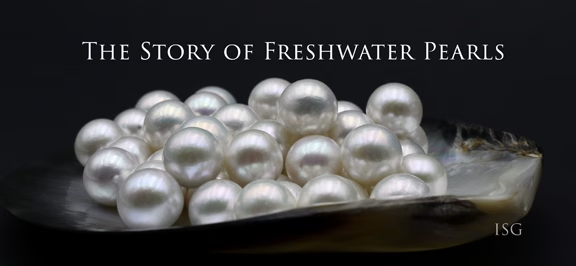
The Story of Freshwater Pearls
For many years, the Chinese freshwater pearl industry produced what were known as “rice pearls.” As the name suggests, these were strands of cultured pearls from the rivers of China that looked like oversized grains of rice. They were cheap, not very pretty, and used mostly by hobbyists to create cheap jewelry.
Then, in the early 1990s the Chinese pearl growers started developing new methods to get the more and better pearls from the huge bivalve mussels that lived in the Yangtze River Delta of China. It changed the international pearl markets forever.
The freshwater mussels that the Chinese Freshwater pearl farmers use have two distinct and amazing advantages over their Japanese Akoya pearl counterparts.
First, freshwater mussels are huge and can produce many pearls from a single mussel. Below is an example from our ISG Student Reference Collection where we counted 12 pearls within this single mussel shell.
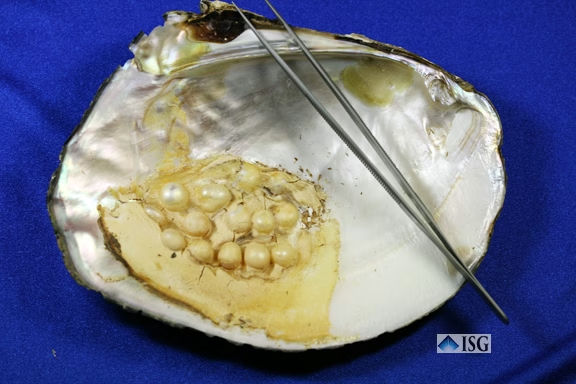
The second advantage is that the mussels can be raised out of the water, opened to allow the farmer to manipulate the pearls, then replace the pearls inside the shell, put the mussel back into the water where it will continue its work to cover the pearls in nacre. As we will see, this allows the non-nucleated freshwater pearls to be produced in beautifully round shapes as seen below.
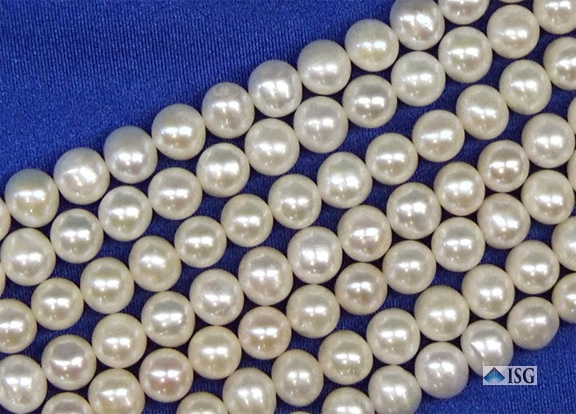
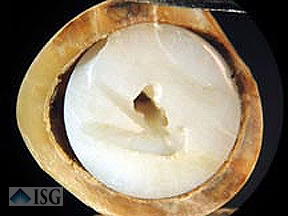 At the ISG, we like to get the inside story about gemstones, and pearls are no exception. To get the inside story of pearls, I realized we need to do so quite literally. At left you see one of the results of cutting a Japanese Akoya pearl in half. The Akoya pearls use starter beads made from mollusk shells from the Mississippi River in the United States. At left is an example of the nacre layer around the starter bead. This is not how Chinese freshwater pearls are grown.
At the ISG, we like to get the inside story about gemstones, and pearls are no exception. To get the inside story of pearls, I realized we need to do so quite literally. At left you see one of the results of cutting a Japanese Akoya pearl in half. The Akoya pearls use starter beads made from mollusk shells from the Mississippi River in the United States. At left is an example of the nacre layer around the starter bead. This is not how Chinese freshwater pearls are grown.
Below is the result of cutting a Chinese freshwater pearl in half (below left) and a Japanese Akoya pearl (below right). As you can see, the freshwater pearl shows the mantle tissue used as a starter for the pearl. These are called “non-nucleated” since the tissue is not a starter bead but merely a mass of tissue. On the right one can clearly see the starter bead of this Akoya pearl. The important point is that the freshwater pearl shows the various layers where the pearl was removed from the mussel, rounded off, and placed back into the mussel to eventually create a round pearl.
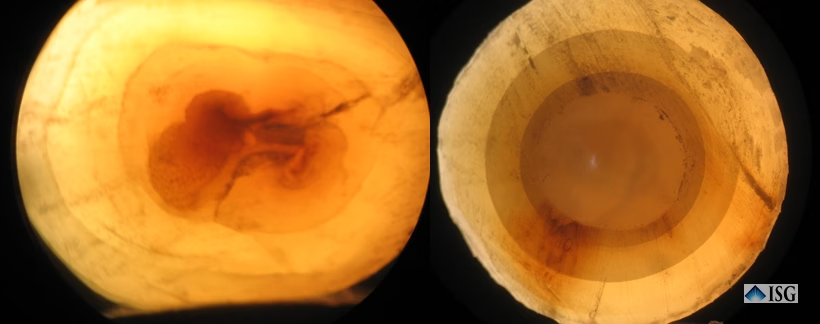
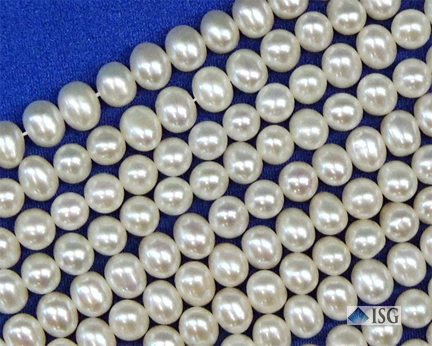 Since each Chinese freshwater mussel produce huge numbers of pearls, and these can be manipulated throughout the growing process, this has allowed the Chinese freshwater pearl industry to become the largest producer of cultured pearls in the world.
Since each Chinese freshwater mussel produce huge numbers of pearls, and these can be manipulated throughout the growing process, this has allowed the Chinese freshwater pearl industry to become the largest producer of cultured pearls in the world.
Before we leave our Story of Chinese Freshwater Pearls, we should offer a few caveats for those seeking to expand your revenue streams into this important gem. First, there is a misconception that pearls are strung with individual knots to keep them from scattering all over the floor if the string breaks. While this is certainly an advantage, it is not the real purpose. In truth, the knots on a strand of pearls are there to protect the pearls. The knots should be of size and position to prevent each pearl from rubbing against each other and doing damage over time. Below is an example of how a pearl necklace should not be strung as these knots are loose and allow the pearls to scratch each other.
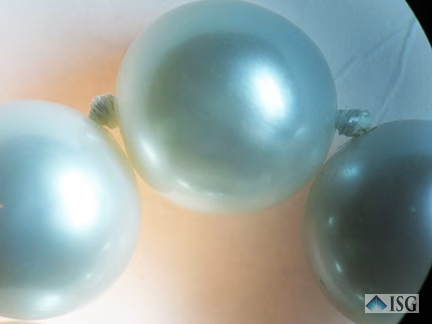
#image_title
Next, there are many treatments of pearls to produce more valuable colors. Some you can identify, some you cannot. In the case of dyeing to artificially produce the valuable black pearl color, one can often identify this treatment by close inspection of the drill hole done for stringing. As seen below, the dye used to create this black pearl is easily visible under 10x magnification. Not always found, but when it is seen it is diagnostic for dyed pearl color.
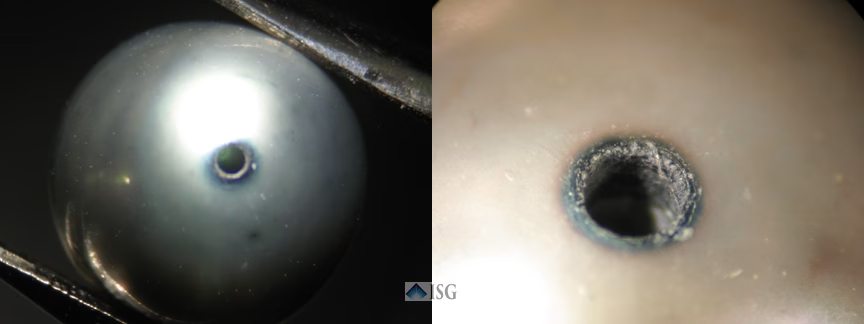
Freshwater pearls should be an important revenue stream for all hometown independent retail jewelers. Affordable freshwater pearl jewelry is the perfect gift for traditional events like a Quinceañera, Weddings, Birthdays, Graduations, Anniversaries, the list goes on and on.
The investment is low, and profits are high. What more can you ask for in terms of a revenue stream for your jewelry store? Think about Chinese Freshwater Pearls during your next buying trip..